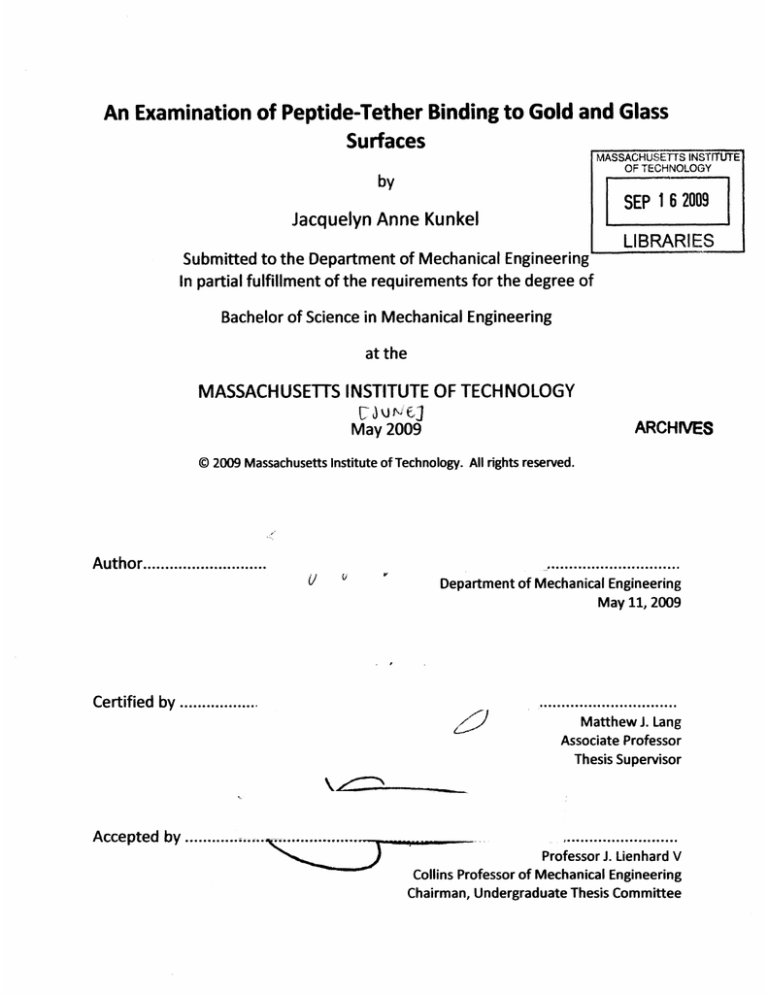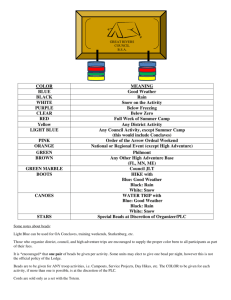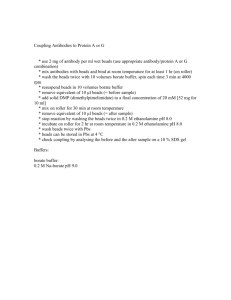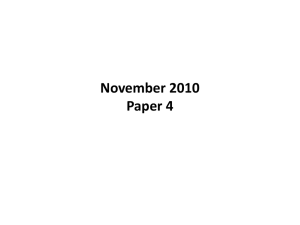
An Examination of Peptide-Tether Binding to Gold and Glass
Surfaces
MASSACHUSETTS INSTFUTE
OF TECHNOLOGY
by
SEP 162009
Jacquelyn Anne Kunkel
LIBRARIES
Submitted to the Department of Mechanical Engineering
In partial fulfillment of the requirements for the degree of
Bachelor of Science in Mechanical Engineering
at the
MASSACHUSETTS INSTITUTE OF TECHNOLOGY
ARCHIVES
May 2009
© 2009 Massachusetts Institute of Technology. All rights reserved.
Author ............................
..............................
Department of Mechanical Engineering
May 11, 2009
Certified by ...............
4:I
Accepted by .....................
Matthew J. Lang
Associate Professor
Thesis Supervisor
.........................
Professor J.Lienhard V
Collins Professor of Mechanical Engineering
Chairman, Undergraduate Thesis Committee
An Examination of Peptide-Tether Binding to Gold and Glass Surfaces
by
Jacquelyn Anne Kunkel
Submitted to the Department of Mechanical Engineering
on May 11, 2009 in partial fulfillment of the
requirements for the degree of
Bachelor of Science in Mechanical Engineering
Abstract
For many biological applications, it is beneficial to know that a peptide will bind to a surface. In
this thesis, a tether, bead, peptide complex is constructed using the gold binding peptide (GBP)
of sequence (CGGVSGSSPDS). Several assays and assay modifications are developed and tested
to attempt to attach the GBP first to a gold slide and then to gold nanoparticles. Four peptides:
K2, K3, known to bind to sapphire were attached to glass to see if it was possible to
modify the sapphire assay to work with glass.
FO 2, K1,
Thesis Supervisor: Matthew Lang
Title: Associate Professor, Mechanical Engineering and Biological Engineering
Background
I.
Peptide Binding
Knowing that a peptide from a natural amino acid binds to a surface provides information for
biological applications, showing that protein and cell deposition can occur without additional
chemical reactions [4]. Specific binding is also useful for producing biosensors and other self
assembling components [6,1]. Peptide display is a common method to determine whether or
not a peptide can attach to a surface. Large groups of peptides are displayed on bacteria,
bacteriophage, or beads, so that a single sequence of the amino acid can be picked for its
binding capabilities. This process can be accomplished by creating a few new phages with
different genes inserted into their genomes. The most desirable phage is selected for and
amino acids are added to its library. Large amounts (10x) of the phage with the added amino
acids are exposed to the binding surface and the ones that adhere are kept and analyzed [2,3].
There were six metabolically stable gold binding peptides found by Brown, the peptide that
contributed to the greatest fraction bound has the following sequence: (alPRGvYKIDSNmh)g.
Ionic bonds, hydrogen bonds, and hydrophobic interactions primarily contribute to peptidesurface binding [1]. Studies with sapphire show that ionic bonding, and bonding between hydroxyl
groups and metal ions (divalent metal ion bridging), allow attachment to occur. The strength of the
peptide surface bond isdetermined by three factors: the number of charge interactions, the strength of
the charge interaction, and the orientation of the charge groups relative to the surface [4]. The way
peptides bind to the surface allows for binding specificity. Agold binding peptide (GBP) engineered to
attach to inorganic surfaces, specifically gold, was shown to attach more readily to gold than sapphire.
The streptavidin on the gold quantum dots bound to biotin (on GBP1) [5].
Peptides were attached to three different surfaces in this thesis: gold coated slides (1" x 3" x
0.04" Cr/Au), gold nanoparticles, and glass. The gold binding peptide of sequence
(CGGVSGSSPDS) was selected because of its strong affinity for gold. The peptide contains four
serines that all have a hydroxyl groups on their side chains. Hydroxyl groups have been found
to bind well to gold surfaces [3]. Four peptides that were proven to bind to sapphire were
tested to see if they could also bind to glass [1]. The four peptides chosen to test were F02
(KRHKQKTSRMGK), K1 (GK) 6, K2 (GGKK) 3, K3 (GGGKKK) 2.
II.
Construction of Tethers
It is important to choose a tether that will not interact with the surface and where one end of
the tether only binds to the peptide and the other only to a bead. DNA was used as the tether
in all experiments performed in this thesis. DNA is beneficial to use because it is easy to make
the molecule any desired length and concentration using PCR. Problems sometimes arise when
using DNA because the DNA backbone is negatively charged. If the peptide binds to a surface
that is positively charged, the DNA will bind to the surface, eliminating its usefulness [1].
The beads attached to the tether were 0.8pm polystyrene beads that could easily be seen
through a microscope. The goal of the each of the assays was to produce single molecule
tethers. Two important considerations were taken into account when creating the assays.
Primarily, a peptide attached to a tether should bind to the surface and a control tether without
a peptide attached should not bind to the surface. Also, as the concentration of peptide tethers
increased, the number of beads attached to the surface should increase as well [1]. If both of
these conditions are met, the assay should be successful in creating a peptide/tether surface
attachment.
Experimental Procedure - Gold Experimentation
I.
Gold Slide Setup
Gold slides 1" x 3" X .040" Cr/Au were purchased from EMF. Four pieces of 3M Scotch 665
removable double sided tape was placed on the gold slide and a glass coverslip was placed over
the tape (with the longer side perpendicular to the longer side of the gold slide), creating three
channels. The gold slides could be used again after soaking them in soapy water for the night.
The tape and coverslide were easy to remove after being soaked but the gold slides scratched
easily. Care had to be taken at all times not to scratch the gold or the washes during the assay
would not be as successful.
control
sample 1
sample 2
glass coverslip
Figure 1. Flow channel setup on a gold slide.
II.
gold slide
Tether Development
DNA tethers were constructed via PCR. A 1010bp dsDNA tether was made with a biotin
molecule (300 nm) on one of its 5' ends and a digoxineginin on the other. The PCR was
completed using a biotin conjugated forward primer (5' - biotin - AAT CCG CTT TGC TTC TGA CT
- 3') and an amine conjugated reverse primer (5' - NH2 - TTG AAA TAC CGA CCG TGT GA - 3')
on the M13mp18 plasmid. All of the PCR ingredients were added to a PCR tube and the
appropriate program was run on the DNA engine. The PCR products were cleaned with the
QiaQuick purification kit and the DNA concentration was measured using the Nanodrop.
The next process in the gold binding assay was to attach the DNA tether to the peptide through
Sulfo-SMCC conjugation. The Sulfo-SMCC was attached to the DNA through the terminal amine
group. After adding the DNA to the linker, the two were incubated for 2 hours at 4 degrees
Celsius. The DNA-SMCC was cleaned using a Bio-Rad column and the product was spun at
1000 x g for 4 minutes. Once the DNA and SMCC were attached, the peptide could be added
because the peptide attaches to the SMCC. The gold peptide has a N-terminal cysteine which
provides the necessary sulfhydryl group needed to attach the peptide to the SMCC [1]. The
DNA-SMCC-Peptide mixture was incubated overnight at 4 degrees Celsius. In the morning, the
product was cleaned using a Bio-Rad Micro Bio Spin 30 column and the tether construction was
complete.
SMCC linker
Peptide
-
- DNA tether
Figure2. Tethered peptide attached to a surface.
Ill.
Assay Development
The first goal of the assay development was to see if the beads alone attached to the gold
slides. It is not desirable to have the beads attach to the slide, so the assay should be
constructed in such a way that only the peptide attaches to the surface of the slide.
Streptavidin coated 0.8pm beads were flowed through three channels. In the first channel,
beads stored in PBST were flowed through. In the second channel, beads incubated in Casein, a
blocking protein, were added. Beads coated with 200bp DNA were flowed through the third
channel. It was beneficial to have all channels, including the control, located on the same slide
because it made it easy to guarantee a comparison was done on the same surface of the slide.
The microscope could be moved from one channel to the next over the tape without changing
the position.
As expected, the channel with the beads in PBST had the greatest number of beads bound to
the slide. The beads covered in DNA to prevent non specific adhesion had less beads bound to
the slide, but not the least. Channel two, the beads covered with Casein, had the least number
of beads bound to gold. The exact number of beads in each channel was impossible to
determine because there were too many beads to count. This experiment provided good
insight into the formation of the gold binding assay. Beads should be covered in Casein before
flowing them through the channels.
Beads
Casein Beads
DNA Beads
Figure 3. Flow channel with three different types of beads
The gold binding assay was tried on a double channel gold slide. One of the channels was
loaded with the gold peptide at a concentration of 30 ng/A. The other channel was loaded with
the control DNA, NH2-3500 bp. The slides were incubated at room temperature in a humidity
chamber for one hour. While the slides were incubating, the beads were prepared. 0.811m
streptavidin coated beads were spun 6 minutes at 10k RPM with PBST. The process was
repeated four times and each time the beads were washed in PBST, except for the final time,
when they were suspended in casein. CBPST (Casein in PBST) was made and flowed through
the cells to prevent the beads from binding to the surface. Another 30 minute incubation
followed the adding of the Casein. The beads were sonicated before they were loaded into the
channels to prevent clumping. A 30 minute incubation took place after the beads were added,
and when time was up, a final wash through with CPBST was executed. Once washed, the
slides were ready to examine.
IV.
Results of the Gold Binding Assay
The first attempt at the gold binding assay was not successful. The channel with the gold
peptide at a concentration of 30 ng/A contained a large amount of stuck beads. Hardly any
moving beads were present at all. Because the beads were coated with casein, only a few stuck
to the surface. The major contribution to the amount of beads present was due to the DNA
tethers. The DNA ended up sticking to the slide and not the peptide, which made it look like
the beads were stuck to the surface. The control looked similar to the gold peptide channel but
had a larger quantity of stuck beads.
The assay was tried two more times. The first time the concentration of the gold peptide was
reduced to 3 ngXf and the second time the concentration was reduced to 0.3 ng/X. In both
cases, it was hard to tell which surface of the slide was being viewed while looking in the
microscope, and the large presence of stuck beads still covered the slides in both the sample
and control channels. The slides were also close to opaque making any observations hard to
acquire. A final change was made to the assay to try to reduce the number of stuck beads.
Instead of coating the beads in Casein, PEG was used to attempt to reduce the number of DNA
tethers attached to the beads.
V.
Gold Binding Assay Modification
PEG, polyethylene glycol, was used to coat the beads so that the desired amount of DNA would
cover the beads. Coating the beads in PEG makes them much more resistant to DNA
absorption allowing only a few tethers to attach to the beads as opposed to having the beads
completely covered by tethers. To cover the beads in PEG, the amine coated polystyrene beads
were first spun at 6K rpm in water. The beads were then resuspended in PEG and incubated
overnight. Before using the beads they were washed in water and spun for 10 minutes at 3K
rpm (this process was repeated two more times).
Bead coated with PEG
Bead coated with casein
Figure 4. DNA tethers attached to coated beads
To test the PEG assay, the beads and PEG were loaded onto a gold slide. Minimal
improvements were accomplished with this test. There were still many beads stuck to the slide
in all channels. Due to the fact that a promising gold slide assay was not yet developed and the
difficulty surrounding the viewing of the slides with the microscope, further testing was
abandoned. Another method for testing the gold binding peptide needed to be found. The
next attempt was made using gold nanoparticles.
VI.
Gold Nanoparticles
The motivation for using gold nanoparticles was to make the results more visible. Instead of
using an almost opaque gold slide, a glass slide with small gold particles would be easy to view.
The same gold binding peptide was added to attach to the gold. The gold nanoparticles came
as a liquid and were stuck on the glass slides by non specific adhesion.
Two channels were constructed on the slide. A mixture of 5pL of 0.8pm nanoparticles, 5pm of
30 ng/A gold peptide-DNA, using the same DNA tether as before, and 20PiL of PBST was added
to the first channel. 5pL of 0.8mm beads and 25pL of PBST was added to the second. The slide
was incubated for one hour and then 5pL of 60mg/pL of 200bp DNA was added to both
channels, which acted as a blocking agent. After the DNA was added the slide was incubated
for an additional 30 minutes. During incubation the beads were prepared by spinning and
resuspending them in PBST. The beads were added after the completion of the incubation and
then the slide was put back in the humidity chamber for an additional 30 minutes. Once
complete, the final step was the wash with 50pL of PBST.
When examining the slide after the assay was complete, the peptide did not appear to attach to
the gold nanoparticles. The gold nanoparticles were visible with the microscope, but nothing
else was visible on the slide. After testing with both the gold slides and the gold nanoparticles,
it was not evident if the gold binding peptide ever attached to the gold. In case something
went wrong in the construction of the tether, the DNA tethers were remade and one of the
gold slide tests was completed again. The peptide chosen had attached to gold in several other
studies, but even when the tether was rebuilt, the results were the same. The only objects that
appeared on the slides were a large number of stuck beads. Modifications need to be made to
the gold assay to make the beads less sticky. It was later found that the polymer coating on the
gold nanoparticles blocked the binding of the peptide. Further testing could be done to see if
the polymer coating could be removed or nanoparticles without the coating could be found.
Due to the time constraints of this thesis, the direction was shifted to look at glass biding
peptides.
Experimental Procedure - Glass Experimentation
I.
Glass Binding Peptides
There were several peptides engineered by Krauland et. al. that bind to sapphire. These
peptides, K1, K2, and K3 have sequences shown in table one [1]. The goal of this
experimentation was to see if these sapphire binding peptides, along with F02 isolated using a
yeast surface display, will also bind to glass.
Peptide
Sequence
F02
KRHKQKTSRMGK
TF02
KRHKQKTSRMGK + dye
K1
GKGKGKGKGKGK
K2
GGKKGGKKGGKK
K3
GGGKKKGGGKKK
Table 1. Peptides chosen to test on glass
II.
Glass Assay
A standard glass slide with three flow cell channels was constructed by attaching an etched
glass coverslip to a glass slide using double sided tape. Three samples were added to the slide:
the control (1 ng/A NH2), sample one (10 ng/X TAMRA F02), and sample two (1 ng/A TAMRA
F02 ). Another slide with two channels was created for the remaining two samples: sample
three (10 ng/ F02), and sample four (1 ng/X F02). All the samples contained the 3500 bp DNA
tether, already attached to the peptide prior to loading. TAMRA is a protein dye that reacts
with the amine terminus of proteins to form protein-dye conjugates. Once the samples were
loaded, the slides were incubated at room temperature for two hours. 100PL of 1 mg/ml
Casein was next added to the slides and the slides were left for 30 minutes in a humidity
chamber at room temperature. While the slides were incubating, 0.8 pm Streptavidin coated
beads were prepared as they were in the gold binding assay. The final resuspension was done
in 1 mg/ml Casein PBST right before the beads were loaded onto the slide. The beads were also
sonicated at 30 seconds at 30% prior to loading. The slides containing the beads were again left
to incubate for 30 minutes in the humidity chamber. The final wash through was with Casein.
The same assay was used to create the slides with the K1, K2 and K3 samples. The 1 ng/X NH2
control was used, and this time there were six other samples: K1 at 1 ng/A and 10 ng/A, K2 at 1
ng/A and 10 ng/A, and K3 at 1 ng/A and 10 ng/A. The 3500 bp DNA tether was once again
attached to all the samples and the NH2 before loading the samples onto the slide. The
procedure for attachment can be found in Section II: Tether Development.
III.
Results of Glass Assay
Each of the 12 slides were examined using a microscope and the number of tethers were
counted by picking 10 random locations, counting the number of beads in the view of the
microscope, and then taking an average. The height of the bars below corresponds to the
number of tethers seen in the view of the microscope at one time using the camera view.
The error bars were generated using a 95 percent confidence interval. The labels on the
horizontal axis of the graph name the peptide.
160
-------..
------
140
.
120
100
.
.
- ---
-I
.
80
60
40
20 T--
F02, 1 F02, 10 control TFO2, 1 TFO2,
K1, 1
K1, 10
Peptide
Figure 5. Number of tethered peptides bound to glass
K2, 1
K2, 10
K3, 1
K3, 10 control
Overall, the FO2 slides contained several more tethers than the K1, K2, K3 slides. The TAMRA
slides contained less tethers than the slides without TAMRA, showing that the dye somewhat
restricted the binding of the peptide to the surface. The K1, K2, K3 peptides have a weaker
binding affinity to glass, but because the peptides did bind to glass, further experimentation
should be done to see what concentration and conditions would increase the number of
peptides bound.
Conclusion
Similar assays were used to bind the GBP to gold and the five sapphire binding peptides to
glass. Although the gold assay was not successful, it was useful to see the versatility of the
assay, which was successful in binding the peptides to glass. A few more changes might make it
possible to bind the GBP to gold nanoparticles. Future work could also be done on the glass
peptides using the optical trap to pull on the tethers to get a distribution of pull forces.
References
[1] D. Appleyard. Engineering optical traps for new environments and applications in the
measurement of biological adhesives and motors. PhD thesis, Massachusetts Institute of
Technology, 2008.
[2] Stanley Brown. Metal-recognition by repeating polypeptides. Nature Biotechnology, 15,
1997.
[3] Yu Huang, Chung-Yi Chiang, Soo Kwan Lee, Yan Gao, Evelyn L.Hu, James De Yoreo, and
Angela M. Belcher. Programmable Assembly of Nanoarchitectures Using Genetically
Engineered Viruses. Nano Letters, 5(7):1429-1434, 2005.
[4] Eric M. Krauland, Beau R.Peelle, K. Dane Wittrup, Angela M. Belcher. Peptide Tags for
Enhanced Cellular and Protein Adhesion to Single-Crystalline Sapphire. Biotechnology and
Bioengineering,97(5), 2007.
[5] Candan Tamerler, Memed Duman, Ersin Emre Oren, Mustafa Gungormus, Xiaorong Xiong,
Turgay Kacar, Babak A. Parvi, Mehmet Sarikaya. Materials Specificity and Directed Assembly of
a Gold-Binding Peptide. Small, 2(11), 2006.
[6] Richard G. Woodbury, Cecilia Wendin, James Clendenning, Jose Melendez, Jerry Elkind,
Dwight Bartholomew, Stanley Brown, and Clement E. Furlong. Construction of biosensors using
a gold-binding polypeptide and a miniature integrated surface plasmon resonance sensor.
Biosensors and Bioelectronics, 13(10):1117-1126, 1998.






